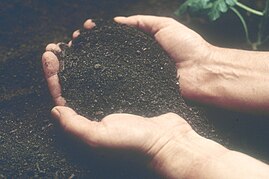This article may need to be rewritten to comply with Wikipedia's quality standards. (September 2024) |

Soil regeneration, as a particular form of ecological regeneration within the field of restoration ecology, is creating new soil and rejuvenating soil health by: minimizing the loss of topsoil, retaining more carbon than is depleted, boosting biodiversity, and maintaining proper water and nutrient cycling.[1] This has many benefits, such as: soil sequestration of carbon in response to a growing threat of climate change,[2][3] a reduced risk of soil erosion,[3] and increased overall soil resilience.[1]
- ^ a b Lal, Rattan (2015-05-13). "Restoring Soil Quality to Mitigate Soil Degradation". Sustainability. 7 (5): 5875–5895. doi:10.3390/su7055875. ISSN 2071-1050.
- ^ "Healthyag - Soil". www.healthyag.com. Retrieved 2015-12-24.
- ^ a b Allen, Henry L.; et al. "The Use of Soil Amendments for Remediation, Soil Amendments for Remediation, Revitalization, and Reuse" (PDF). United States Environmental Protection Agency. EPA/National Service Center for Environmental Publications. Retrieved 2019-11-14.
